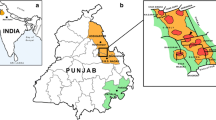Abstract
Bioavailability and possible benefits of wheat intake naturally enriched with selenium and its products was tested. Wheat obtained by application of an original combination and procedure for foliar supplementation of plants with Se was characterized on the average by five times higher content of Se, the main form being l-(+)-selenomethionine (SeMet). Substitution of Se-deficient wheat by wheat naturally enriched with Se and its products contributed to the increase of daily intake on the average by 18 µg (12–35 µg) in volunteers, which is more than 50% of the average daily intake.
Six weeks after the beginning of its application, increased daily intake of Se brought about the increase of its concentration in the plasma of the examined persons by 53%, in their erythrocytes by 37%, in their hair by 44%, and in their urine by 54%. This result was comparable to the effect obtained in the course of an 8-wk daily intake of supplements with 100 µg Se in the form of enriched bakery yeast.
Analysis of glutathione peroxidase (GSH-Px) activity in blood, thiobarbituric acid reactive substances (TBARS) in plasma, lipid parameters (total cholesterol, high-density lipoprotein cholesterol, low-density lipoprotein cholesterol, and triglycerides), and glucose in serum of volunteers showed that the increased Se intake induced increased GSH-Px activity in blood and decreased concentrations of TBARS, lipid parameters, and glucose in blood.
Using only one crop (wheat enriched with Se), the existing deficiency of Se in our population can be alleviated. In this way, one-fourth of our population with lower Se intake than 21 µg/d will satisfy basal requirements, whereas one-half will become moderately deficient in Se instead of distinctly deficient in Se.
Similar content being viewed by others
References
J. E. Oldfield, Feedstuffs. 5, 11 (1990).
J. A. Tan and Y. Huang, Water Air Soil Pollut. 57–58, 59 (1991).
CAS: The group of Environmental and Endemic Diseases—Institute of Geography, J. Chin. Georgr. 1, 71 (1990).
V. R. Young, A. Nahapetanin, and M. Janghorbani, Am. J. Clin. Nutr. 35, 27 (1982).
L. Johnsson, B. Åkesson, and J. Alexander, Swedish Environmental Protection Agency, Stockholm, p. 51 (1997).
I. H. Waschulewski and T. D. Sunde, J. Nutr. 118, 367 (1988).
N. Esaki, T. Nakamura, H. Tanaka, and K. Soda, J. Biol. Chem. 257, 4386 (1982).
H. E. Ganther, Biochemistry 7, 2898 (1968).
H. E. Ganther, Biochemistry 10, 4089 (1984).
M. Bjornstedt, S. Kumar, and A. Holmgreen, Methods Enzymol. 252, 209 (1995).
S. C. Low, J. W. Harney, and M. J. Berry, J. Biol. Chem. 270, 21,659 (1995).
M. Janghorbani, R. F. Martin, L. J. Kasper, X. F. Sun, and V. R. Youg, Am. J. Clin. Nutr. 51, 670 (1990).
FAO/IAEA/WHO (Food and Agricultural Organization/International Atomic Energy Agency/World Health Organization), Trace Elements in Human Nutrition and Health, World Health Organization, Geneva (1996).
L. Djujic, M. Milovac, and V. Djermanovic, Proceedings Sixth International Symposium on the Uses of Selenium and Tellurium, I. Palmiery, ed., STDA, Brussels, p. 129 (1998).
I. Djujic, in Natural Antioxidants and Food Quality in Atherosclerosis and Cancer Prevention, The Royal Society of Chemistry (Cambridge), p. 199 (1996).
J. A. Butler, C. D. Thomson, P. D. Wrangler, and M. F. Robinson, Am. J. Clin. Nutr. 53, 748 (1991).
Y. Xia, X. Zhao, L. Zhu, and P. D. Whanger, J. Nutr. Biochem. 3, 202 (1992).
Y. Xia, X. Zhao, L. Zhu, and P. D. Whanger, J. Nutr. Biochem. 3, 211 (1992).
Y. Seko, Y. Saito, J. Kitahara, and N. Imura, in Selenium in Biology and Medicine, A. Wendel, ed., Springer-Verlag, Berlin, p. 70 (1989).
J. E. Spallholz, W. Ted, L. Reid, M. Boylan, and B. J. Shriver, Proceedings Sixth Internatyonal Symposium on the Uses Selenium and Tellurium, Y. Palmiery, ed., STDA, Brussels, p. 47 (1998).
I. Djujic, and M. Milovac, Combination used for the foliar supplementation of plants with Se salts and urea, Patent No. WO 99/29639, PCT/YU 98/00022 (1998).
I. Djujic, and M. Milovac, Combination used for the foliar supplementation of plants with Se salts and urea, Patent No. WO 99/29624, PCT/YU 98/00023 (1998).
D. E. Paglia and W. N. Valentine, J. Lab. Clin. Med. 70, 158 (1967).
K. Satoh, Clin. Chim. Acta 90, 37 (1978).
M. Uchiyama and M. Michara, Ann. Biochem. 86, 271 (1978).
D. Drabkin and H. Austin, J. Biol. Chem. 112, 51 (1935).
G. L. Xu, S. C. Wang, B. Q. Gu, Y. X. Yang, H. B. Song, W. L. Xue, et al., Biomed. Environ. Sci. 10, 316 (1997).
P. Ekholm, M. Ylinen, M. Eurola, P. Koivistoinen, and P. Varo, Milchwissenschaft 46, 547 (1991).
P. Varo, Norw. J. Agric. Sci. 11(Suppl.), 151 (1993).
J. Djujic, J. Vucetic, V. Matic, V. Milic, and M. Vrvic, Trace Elements in Health and Disease, G. T. Yurger, O. Donna, and L. Kayrin, eds., Curukova University, Adana, Turkey, p. 579 (1991).
H. M. Meltzer, K. Bibow, I. T. Paulsen, H. H. Mundal, G. Norheim, and H. Holm, Biol. Trace Element Res. 36, 229 (1993).
Y. Xia, K. E. Hill, and R. F. Burk, J. Nutr. 119, 1318 (1989).
P. D. Whanger, J. Trace Elements Exp. Med. 11, 227 (1998).
J. T. Salonen, R. Salonen, K. Seppānen, M. Kantola, M. Parvianen, G. Alfthan, et al., Atherosclerosis 70, 155 (1988).
P. Suadicani, H. O. Hein, and F. Gyntelberg, Atherosclerosis 96, 33 (1992).
Author information
Authors and Affiliations
Rights and permissions
About this article
Cite this article
Djujić, I.S., Jozanov-Stankov, O.N., Milovac, M. et al. Bioavailability and possible benefits of wheat intake naturally enriched with selenium and its products. Biol Trace Elem Res 77, 273–285 (2000). https://doi.org/10.1385/BTER:77:3:273
Received:
Accepted:
Issue Date:
DOI: https://doi.org/10.1385/BTER:77:3:273




